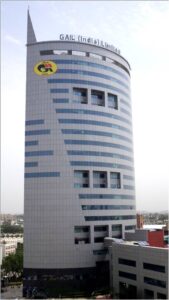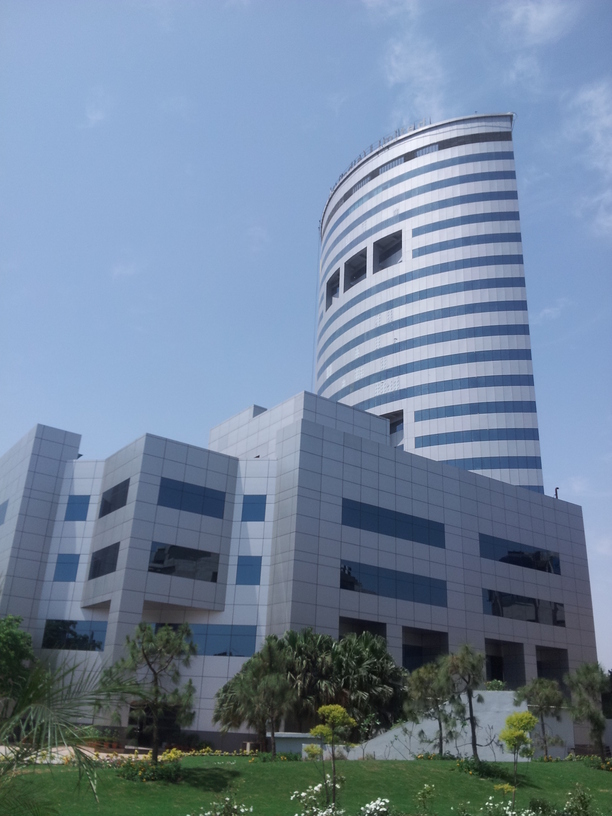The GAIL Jubilee Tower: Promoting a green culture

“Sustainable buildings are: Lovable because if they can’t be loved, they will not last; durable, because they must endure, if they’re to be sustainable; flexible, because if they endure, they will need to be used for many uses over the centuries; frugal, because energy hogs can’t be sustained in a healthy way long into an uncertain future.”
-Steven Mouzon.
Promoting a green culture is just as important today as producing more and more green buildings. If the users of a building do not follow green habits, it’s very difficult to maintain its green character for long. However, if the entire structure encourages the occupants to become environment-friendly through its concept and practices, it sends out a strong message: we want to give our planet a chance. Today we are going to talk about a building that sets new standards in the field of green architecture in India: The GAIL Jubilee Tower situated in NOIDA, Uttar Pradesh, India.
Reflecting the company’s philosophy
GAIL (India) Ltd. Is the largest natural gas processing and distributing Public Sector Undertaking (PsU) in India with an endeavor to provide green energy at competitive rates. The company decided to build its corporate office in NOIDA in the Delhi NCR area to commemorate its 25th year of establishment. The company wanted to symbolize its concept of clean energy and clean environment through an iconic tower, a tower that would be a manifestation of its own philosophy. The building, completed in 2014, was named the GAIL Jubilee Tower.
One of the tallest green office buildings in the country- standing at 387 feet or 116.1 mts- The GAIL Jubilee Tower has incorporated many new design features and technologies to ensure energy efficiency and a healthy work environment for the users. It has received the platinum rating- the highest LEED rating for green buildings worldwide.
Green features
The architects Nirman Consultants Pvt Ltd (NCPL) and developers GAIL India Ltd conceptualized a 24-story structure that doesn’t only meet all the green standards and norms but also conforms to the functional and aesthetical norms of a corporate office. Many innovations are used in the building to ensure that all the green goals are met- energy efficiency, water conservation, waste management, environment friendly technologies and materials. It would be interesting to take a look at some of these green features:
- Building orientation and aerodynamic shape
An integrative design approach was adopted to ensure the energy efficiency, one of the main goals of the project. The building was placed in North-South direction ensuring maximum wind and sunlight while blocking excessive heat from the sun. An aerodynamic shape was especially adopted to allow natural windflow at all times, not only keeping the temperature of the external surface lower but also ensuring that the surroundings also remain cooler.
- Less energy consumption
The GAIL Jubilee Tower is designed at 400 SqFt/ ton as against the customary 250 SqFt/ ton for office buildings in Delhi NCR. This helped in reducing the size of mechanical equipment by lowering the energy needs. The other innovations used to minimize the energy consumption were high performance double-layered glazing, effective insulation including that of metal parts, and highly reflective roof etc.
- More day lighting
A very low power density is ensured by designing the interior spaces in such a way as to provide sun lighting to all the work stations throughout the day. In addition, convex reflectors are sandwiched between two layers of window glass panes to ensure a deeper penetration of the day lighting. Use of dimmable light fixtures and lux level sensors etc are some more ways for minimizing the energy needs.
- Use of clean energy
This was another innovation that gives the GAIL Jubilee Tower a different character. As GAIL is one of the largest producers of natural gas, it was decided that the building would generate its own power using natural gas instead of taking power from the state electricity board to ensure use of clean power. HVAC is also run through VAM systems that results in high indoor environmental quality, operational efficiency and waste and toxic reduction.
- Water conservation and zero-discharge facility
A zero-discharge facility is installed to ensure minimum wastage of water. Waste water is collected, treated and reused for various non-potable purposes like horticulture and cooling towers etc. Low flow water fixtures and aerators are used to minimize wastage of water. In addition, VFDs are used in pumps and motors to lower the energy consumption.
- Quality of indoor air
CO2 sensors are used to ensure good quality air indoors. This also ensures that when the building is empty or partially filled, less power is used to send in fresh air, saving precious energy while making sure that the comfort level is not compromised.
Propagating a green culture and spreading awareness among the population that no half measures are going to save the world is the need of the hour. Our buildings should not only consume less energy and conserve water but must also educate people about the virtues of adopting green habits. Remember, we are racing against time to save the planet, and ourselves too.
The GAIL Jubilee Tower is a ground-breaking project by NCPL that expresses the company’s priority to make its buildings energy-efficient and eco-friendly. We shall keep sharing more informative posts, don’t miss the fun!

